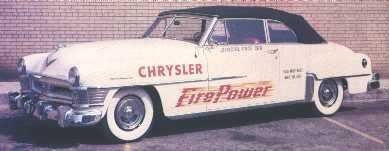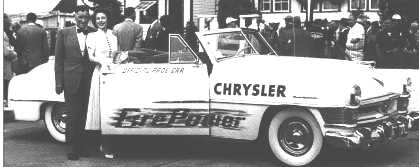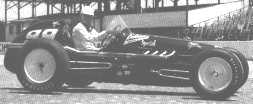![]()
![]()

1951 Chrysler New Yorker

Chrysler's first new postwar designs debuted for 1949 and the styling, characterized by massive chrome grilles, didn’t change much until the classic Virgil Exner redo for 1955. However, there was an under-skin development of historic significance in 1951: introduction of the hemi V-8.
It debuted in the Saratoga, New Yorker, and Imperial, and earned pace car honors for the New Yorker. An engine of legendary strength, the hemi quickly earned its reputation, pushing a Saratoga to first in the Stock Class and third overall—behind a Ferrari—in the 1951 Mexican Road Race. It would go on to power some of the fastest cars Detroit ever built and today catapults quarter-mile drag racers to over 300 mph.
Though the "Fire Power" hemi-head V-8 had an immediate impact on Chrysler's image, its deep-breathing configuration wasn’t new. But Chrysler was the first to use it for a modern high-compression passenger-car engine.
The hemi had plenty of power even in initial 331-cid form; an early prototype recorded 352 horsepower in the dynamometer after some elementary modifications. But it was complex and costly to build, and the cylinder heads, which formed the hemispherical combustion chambers that give the engine its name, were massive. Chrysler phased out the hemi by 1959 in favor of more conventional "wedge-head" V8s, but the engine was too good to lose and would return as the Hemi in the great Dodge and Plymouth muscle cars of the sixties.

Specifications
Body style: 2-door convertible
Engine: 331-cid ohv V-8
Bore x stroke (in.): 3.81 X 3.63
Horsepower: 180 (gross)
Transmisslon: 2-speed semi-automatic
Driver: David A. Wallace
In the 1951 New Yorker, the engine had a two-barrel Carter carburetor, a five main bearing crankshaft, 7.5:1 compression, and made peak horsepower at 4000 rpm. The ragtop pace car had a front coil suspension and rear leaf springs. The New Yorker’ shared a 131.5-inch wheelbase with the Imperial and weighed 4460 pounds. The Saratoga club coupe, by contrast, had a 125.5-inch wheel base and weighed just 3948 pounds. A hemi Saratoga was Chrysler’s fastest car to 1955, capable of 0-60 mph in 10 seconds and 110 mph right of f the showroom floor. But New Yorker was the flashier model, and—with the new hemi—had plenty of power for anything the Speedway asked it to do.
The Driver: It’s fitting that a former chief engineer for Chrysler Corporation was behind the wheel of the engineering-rich New Yorker. David A. Wallace held 70 patents for various machines and processes when he was hired by K. T. KeIler—then a Chrysler vice president. Wallace ascended to the presidency of Chrysler Division in 1937 and held the office when he drove the ‘51 pace car.
The Race: Lee Wallard’s roadster looked like nothing more than a stretched midget dirt-track car, and its 241-cid Offy was the smallest unsupercharged engine in the race. But he qualified in the middle of row one, was among only eight competitors to finish in the blistering heat, and won his first and only 500. Wallard also was the first to finish in under four hours - three hours 57 minute.
 Winner
Winner

Back
to Main Index
![]() [email protected]
[email protected]